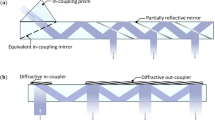Abstract
Optical experiments on butterfly compound eyes show that they have angular sensitivities narrower than expected from conventional apposition eyes. This superior performance is explained by a theoretical model where the cone stalk is considered as a modecoupling device. In this model the Airy diffraction pattern of the corneal facet excites a combination of the two waveguide modes LP01 and LP02. When the two modes propagate through the cone stalk the power of LP02 is transferred to LP01 alone which is supported by the rhabdom. This mechanism produces a higher on-axis sensitivity and a narrower angular sensitivity than conventional apposition optics. Several predictions of the model were confirmed experimentally.
Similar content being viewed by others
References
Born M, Wolf E (1965) Principles of optics. Pergamon Press, Oxford
Franceschini N (1975) Sampling of the visual environment by the compound eye of the fly: fundamentals and applications. In: Snyder AW, Menzel R (eds) Photoreceptor optics. Springer, Berlin Heidelberg New York, pp 98–125
Goodman JW (1968) Introduction to Fourier optics. McGraw-Hill, New York
Hateren JH van (1984) Waveguide theory applied to optically measured angular sensitivities of fly photoreceptors. J Comp Physiol A 154:761–771
Horowitz BR (1981) Theoretical considerations of the retinal receptor as a waveguide. In: Enoch JM, Tobey FL Jr (eds) Vertebrate photoreceptor optics. Springer, Berlin Heidelberg New York, pp 219–300
Kuiper JW (1966) On the image formation in a single ommatidium of the compound eye in Diptera. In: Bernhard CG (ed) The functional organization of the compound eye. Pergamon Press, Oxford, pp 35–50
Land MF, Osorio D, Nilsson D-E (1987) Ecological variation in the optical structure of butterfly eyes (in preparation)
Li Y, Wolf E (1984) Three-dimensional intensity distribution near the focus in systems of different Fresnel numbers. J Opt Soc Am A 1:801–808
Lim TK, Garside BK, Marton JP (1979) An analysis of optical waveguide tapers. Appl Phys 18:53–62
Nelson AR (1975) Coupling optical waveguides by tapers. Appl Opt 14:3012–3015
Nilsson D-E, Land MF, Howard J (1984) Afocal apposition optics in butterfly eyes. Nature 312:561–563
Nilsson D-E, Land MF, Howard J (1987) Optical characteristics of the butterfly eye. J Comp Physiol A (in press)
Pask C, Barrell KF (1980a) Photoreceptor optics I: Introduction to formalism and excitation in a lens-photoreceptor system. Biol Cybern 36:1–8
Pask C, Barrell KF (1980b) Photoreceptor optics II: Application to angular sensitivity and other properties of a lensphotoreceptor system. Biol Cybern 36:9–18
Smakman JGJ, Hateren JH van, Stavenga DG (1984) Angular sensitivity of blowfly photoreceptors: intracellular measurements and wave-optical predictions. J comp Physiol A 155:239–247
Snyder AW (1970) Coupling of modes on a tapered dielectric cylinder. IEEE Trans Microwaves Theory Tech 18:383–392
Snyder AW (1975) Photoreceptor optics-Theoretical principles. In: Snyder AW, Menzel R (eds) Photoreceptor optics. Springer, Berlin Heidelberg New York, pp 38–55
Snyder AW (1977) Acuity of compound eyes: Physical limitations and design. J Comp Physiol A 116:161–182
Snyder AW, Love DJ (1983) Optical waveguide theory. Chapman and Hall, London New York
Snyder AW, Laughlin SB, Stavenga DG (1977) Information capacity of eyes. Vision Res 17:1163–1175
Author information
Authors and Affiliations
Rights and permissions
About this article
Cite this article
van Hateren, J.H., Nilsson, D.E. Butterfly optics exceed the theoretical limits of conventional apposition eyes. Biol. Cybern. 57, 159–168 (1987). https://doi.org/10.1007/BF00364148
Received:
Issue Date:
DOI: https://doi.org/10.1007/BF00364148




